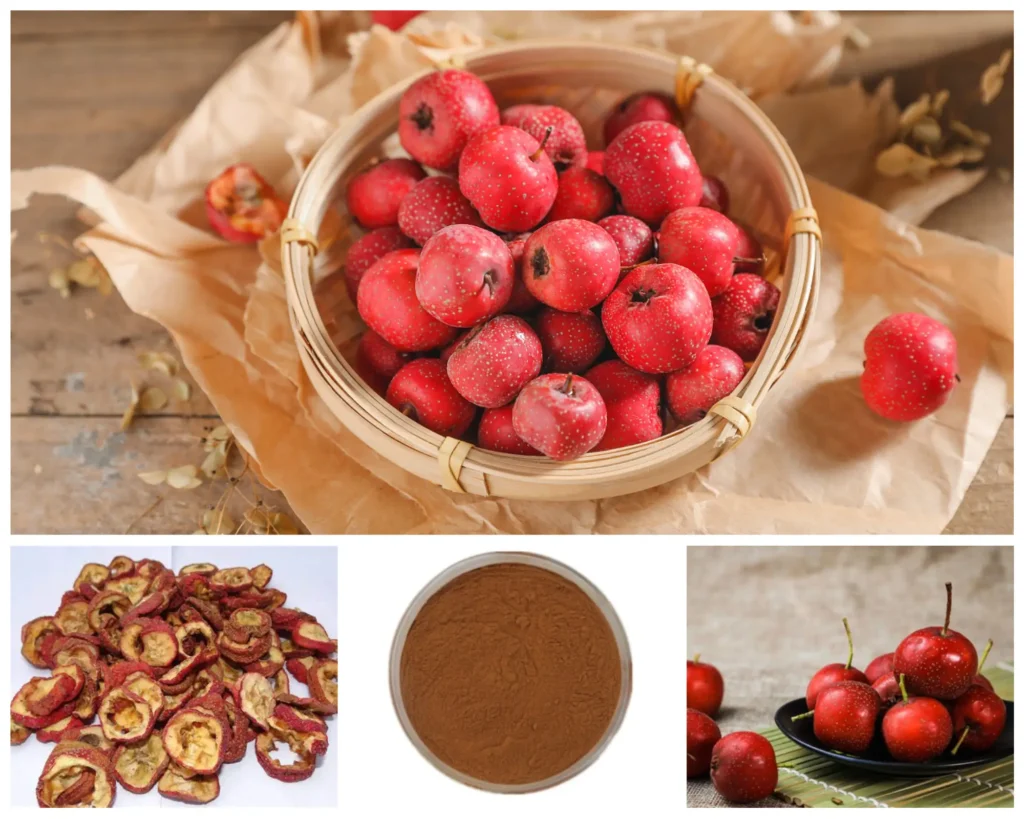Abstract
(1)Main Functions of Hawthorn Polysaccharides
A. Promote Lymphocyte Proliferation
- Activates immune cells like macrophages and dendritic cells.
- Regulates cytokine production, essential for lymphocyte proliferation.
- Activates signal transduction pathways such as MAPK and NF-κB.
- Enhances immune system function and maintains intestinal flora balance.
B. Regulate Intestinal Flora
- Promotes growth of beneficial bacteria and inhibits harmful bacteria.
- Produces short-chain fatty acids that nourish and protect intestinal cells.
- Maintains intestinal microecological balance and overall health.
C. Hypoglycemic
- Inhibits α-glucosidase, delaying carbohydrate digestion and absorption.
- Enhances insulin sensitivity, aiding in blood sugar regulation.
- Exhibits antioxidant and lipid-lowering properties.
(2)Suitable Supplement Forms
- Capsules: Easy to consume and dose accurately.
- Tablets: Convenient form for daily intake.
- Powders: Versatile, can be mixed with food or drinks.
- Liquid Extracts: Rapid absorption, suitable for quick effects.
- Functional Foods: Incorporated into teas, candies, and health drinks, making them easy to integrate into daily diets.
(3)Market Prospects/Advantages
- High Demand in Traditional Medicine: Extensively used in traditional Chinese and Ayurvedic medicines.
- Functional Food Market Growth: Increasing application in health foods like teas and health drinks.
- Health-Conscious Consumer Base: Rising awareness of natural and plant-based supplements boosts market potential.
- Global Reach: Gaining popularity in the US, EU, and Southeast Asia due to its proven health benefits and versatile applications.
(4)Extraction Methods
- Hot Water Extraction: Traditional method for extracting polysaccharides.
- Ultrasonic-Assisted Extraction: Enhances extraction rate and efficiency.
- Enzyme Extraction: Effective for high-purity polysaccharide extraction.
- Microwave-Assisted Extraction: Optimal conditions found to maximize yield.
(5) Common Specifications
- Purity Levels: High-purity products after deproteinization, decolorization, and dialysis.
- Molecular Weights: Specific molecular weights for different polysaccharide fractions.
- Formulations: Available in powders, extracts, and hydrolysates for various applications.

Article Content
1. Health effects of Hawthorn Polysaccharides
A.Promote lymphocyte proliferation
The mechanism by which hawthorn polysaccharides promote lymphocyte proliferation involves multiple levels. First, it can activate immune cells, such as macrophages and dendritic cells, and promote the maturation of these cells by binding to cell surface receptors, which indirectly affects the proliferation of lymphocytes. Secondly, hawthorn polysaccharides can regulate the production of cytokines, including interleukins and tumor necrosis factors, which are essential for the proliferation and differentiation of lymphocytes. In addition, hawthorn polysaccharides may regulate the activity of immune cells by activating signal transduction pathways such as MAPK and NF-κB, thereby affecting the proliferation of lymphocytes. Its antioxidant and anti-inflammatory effects also help maintain the normal function of immune cells and create favorable conditions for lymphocyte proliferation. Finally, by improving the structure of intestinal flora, hawthorn polysaccharides may indirectly promote the overall function of the immune system.
B.Regulate intestinal flora
Hawthorn polysaccharides regulate the structure and function of intestinal flora through interactions with intestinal microbiota. Hawthorn polysaccharides, which are not easily absorbed by intestinal epithelial cells, are mainly decomposed by intestinal flora. The short-chain fatty acids produced during the fermentation process have a nutritional and protective effect on intestinal cells, which helps to maintain the integrity of the intestinal barrier. Hawthorn polysaccharides can promote the growth of beneficial bacteria, such as Megasphaera, Acidaminococcus and Mitsuokella, while inhibiting the proliferation of harmful bacteria such as Escherichia Shigella and Fusobacterium, reducing the abundance of harmful intestinal flora, optimizing the composition of intestinal flora, and maintaining intestinal health. In addition, short-chain fatty acids are also involved in regulating the function of the immune system, further promoting intestinal health. In summary, hawthorn polysaccharides play a regulatory role by promoting the growth of beneficial bacteria, inhibiting the proliferation of harmful bacteria and improving the metabolism of intestinal flora, maintaining the balance of intestinal microecology, and having a positive impact on health.
C.Hypoglycemic
Hawthorn polysaccharides, as the active ingredient in hawthorn, show a significant hypoglycemic effect. Its mechanism of action mainly involves two aspects: First, the inhibition of α-glucosidase, which is responsible for breaking down sugars in the small intestine. Hawthorn polysaccharides inhibit its activity, delay the digestion and absorption of carbohydrates, and thus control the rise of blood sugar after meals. Second, hawthorn polysaccharides can enhance the body's sensitivity to insulin, which helps insulin regulate blood sugar more effectively. In addition, hawthorn polysaccharides also have antioxidant and lipid-lowering properties. These functions work synergistically with flavonoids and phenolic compounds to jointly maintain blood sugar balance and promote overall health.
2. Production technology
The production technology of hawthorn polysaccharides involves extraction, separation and purification. At present, the commonly used extraction methods in research and production include hot water extraction, ultrasonic-assisted extraction and enzyme extraction. Among them, ultrasonic-assisted extraction is considered to be an effective extraction method because it can improve the extraction rate and efficiency of polysaccharides. In addition, microwave-assisted extraction also shows high extraction efficiency and stability, and is an ideal new process. After extraction, steps such as deproteinization, decolorization and dialysis are usually required to purify the polysaccharides to obtain high-purity products suitable for further application. Chromatographic techniques, such as ion exchange chromatography, can be used to further grade and purify polysaccharides.
3. Technical content
This study optimized the microwave extraction process of hawthorn extract by Box-Behnken response surface methodology, and obtained the best extraction conditions of temperature 63℃, microwave power 500W, and extraction time 7 minutes. Under these conditions, the amount of hawthorn polysaccharide extracted was 147.10±0.32 mg/g. Hawthorn crude polysaccharide has a good inhibitory effect on α-glucosidase and pancreatic lipase, and has a good scavenging ability for DPPH free radicals. Its IC50 values are 99.22±0.89, 22.50±0.79, and 185.80±0.64 μg/mL, respectively, indicating that hawthorn crude polysaccharide contains active ingredients for lowering blood sugar and blood lipids, which provides a basis for the further development and utilization of hawthorn.



